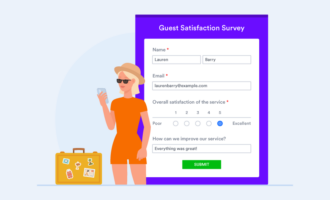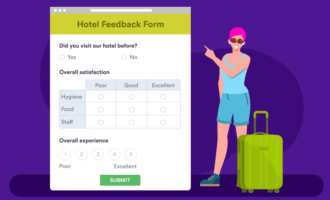Governments, businesses, and individuals often seek out public opinion — and for good reason. When you understand public perception about an issue, a person, or a cause, you can create a more compelling message to encourage or dispel those perceptions. But how is public opinion measured?
Since the early ’90s, surveys have been the go-to method for measuring public opinion. Surveys are regular fixtures of election season, designed to gauge candidate approval ratings. Government agencies also use surveys to understand public feelings toward new and existing policies.
Surveys aren’t limited to politics or government, though. “Surveys are generally a way of knowing the ‘pulse’ of the people you intend to serve,” says Simon Elkjaer, CMO of avXperten.
You could use surveys to gauge public opinion on any matter that concerns a community. A church can use a survey to find out what members think of its annual charity project. A school can use a survey to get feedback on teachers’ performance or to reward initiative.
“Businesses rely on data retrieved from surveys to check how people perceive their marketing, sales, and overall business strategies. The opinions and ideas gained from these surveys give them insight into their customers’ needs and help them modify their services to cater to these needs,” says Elkjaer.
Whatever the goal of your survey, there are best practices you can follow to ensure you get responses that accurately represent public opinion on the subject.
How to measure public opinion accurately using surveys
Here are the five most important steps when conducting surveys to measure public opinion.
1. Define the survey goal
The information you aim to gather in a survey should be clear from the beginning. For example, you may want your book club to name a “Book of the Year.” This means you need to create a list of books and decide how your club should evaluate them.
Without clarity about your survey goal, you risk asking irrelevant questions or choosing the wrong audience.
2. Construct survey questions
Constructing appropriate survey questions is critical to getting responses that truly reflect public opinion. Poorly constructed questions lead to biased responses.
You can use open-ended or closed-ended survey questions. Open-ended questions allow respondents to provide their own answers, while closed-ended questions limit respondents to a set of predefined answers they have to choose from. Both types of questions are important in surveys because they provide different types of information.
Jared Zabaldo, founder of USAMM, says it’s a good idea to include at least one open-ended question.
“While you may get some idea of the information that you’re after through multiple-choice questions, asking those participating to provide a detailed paragraph explaining their answer to your most important question will be extremely helpful,” says Zabaldo.
He explains that it’s often just as important to understand the motives behind a response as it is to record the response itself.
Opinion poll expert Sir Robert Worcester identifies five rules to follow when you’re constructing questions:
- Ask balanced questions. Instead of asking, “Do you support x cause?” ask, “Do you support or oppose x cause?” The first version is a leading question because it points the respondent in a specific direction (support). The second option is more objective.
- Define any ambiguous terms. If your question contains any ambiguous terms or phrases, be sure to explain them. A key rule in crafting good questions is to never assume your respondent has the necessary knowledge to understand everything.
- Use common language. Avoid using uncommon words or phrases that respondents will find difficult to understand. Of course, this depends on the target audience. If you’re surveying high schoolers, the word “use” is probably more common for them than “utilize.”
- Give sufficient background information. If a question mentions the names of specific people, places, or things, explain who or what they are.
- Avoid disapproving or derogatory terms. Similar to the first rule, using a disapproving term nudges respondents in a specific direction instead of allowing a balanced view.
3. Identify and select survey participants
For your survey to follow proper scientific methodology, you need to send it to a representative sample of the group you’re interested in. If you’re surveying a large population, it’s usually impossible to get responses from all the members of your target audience. For example, if you’re interested in the opinion of U.S. college students on a particular topic, it’s impossible to interview every college student in the country.
A representative sample is a subset of the target audience that can accurately represent the opinion of the larger group. One way to ensure that selected participants are representative of your target population is to use appropriate sampling methods, such as simple random sampling.
See this article to learn more about the different sampling methods you can use to ensure the participants you select are representative of your target population.
4. Administer the survey
You can administer surveys in several ways, including by telephone, through the mail, online, in-home, on the street, and using combinations of all these methods. The best method for collecting survey responses will depend on the target audience. For example, you’re more likely to find millennials online, while it’s probably best to survey senior citizens by calling them or visiting them at home.
Online surveys are popular because they’re a fast way to collect responses. Jotform makes it easy to create and administer online surveys, regardless of the audience size. For example, a city government agency conducted this Jotform survey to get feedback on various aspects of a local construction project.
5. Analyze responses
The point of measuring public opinion is to get valuable feedback. Once all of your surveys are complete, analyze responses using the right tools and methods to understand the data you’ve collected.
For example, you can easily quantify and visualize data from closed-ended questions using charts. For open-ended questions, look for patterns in the responses. With the Jotform Report Builder, you can visualize data from survey responses using charts, graphs, and more.
Public opinion is valuable and can provide insight into a wide range of issues. To accurately measure public opinion, employ the right scientific methods and make use of the right tools when you’re collecting and analyzing responses.






































































































Send Comment: